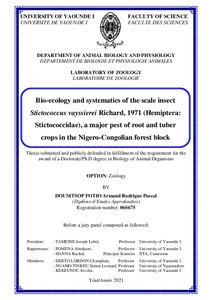| dc.contributor.author | Doumtsop, F.A.R. |
| dc.date.accessioned | 2021-08-02T10:44:21Z |
| dc.date.available | 2021-08-02T10:44:21Z |
| dc.date.issued | 2021 |
| dc.identifier.citation | Doumtsop, F.A.R. (2021). Bio-ecology and systematics of the scale insect Stictococcus vayssierei Richard, 1971 (Hemiptera: Stictococcidae), a major pest of root and tuber crops in the Nigero-Congolian forest block. Yaounde: University of Yaounde I. (189 p.). |
| dc.identifier.uri | https://hdl.handle.net/20.500.12478/7195 |
| dc.description.abstract | Stictococcus vayssierei Richard, 1971 commonly known as the African root and tuber scale (ARTS), was first identified as an agricultural pest in the early 1980s. Following population outbreaks in Cameroon and the Democratic Republic of Congo in late 1980s – early 1990s, the insect is currently reported as one of the major pests threatening root and tuber crop production in Central Africa. Outbreaks can merely be viewed as symptomatic of some breakdown of internal organization and extrinsic factors and, understanding and manipulating the processes causing outbreaks have been at the basis of integrated pest management. However, data on ARTS’ biology are lacking, and its ecology is poorly understood. Further, recent observation provided the basis for the hypothesis that ARTS is a species complex, complicating the development of sustainable management options, particularly host plant resistance. In order to enhance knowledge on ARTS biology and ecology and contribute to the development of solutions aiming at minimizing pest infestations and reducing its damage on crops, this research focused on the farmers’ perception, distribution, life history and diversity among pest populations. Interviews of farmers realized during field surveys using a semi-structured questionnaire revealed that ARTS has been known by the local communities at least since the early 1900s under 41 names of which Kop, Giga, Ognia, Kamsi, Nakandja and Mokanza are the most frequent. But farmers still lack control measures to tackle the pest. Field surveys conducted in cassava-based agroecosystems in Central Africa neighborhood from 2002-2015 showed that ARTS was present in Cameroon, Central African Republic, Congo, Democratic Republic of Congo, Equatorial Guinea, Gabon and Uganda, at altitude above 277 m. It is likely that the pest is expanding its range and invading new habitat as it occurred not only in the forest, but also in the moist savannah where it was never recorded before. However, prevalence was higher in the forest where cassava was the most infested crop, compared to the savannah where aroids (cocoyam and taro) were the most infested crops. High densities (> 1000 scales/plant) were recorded along the Cameroon-Gabon border. Scale cohorts reared on cassava cuttings and cocoyam corms (females) and in plastic tubes (males) in environment chambers at six constant temperatures showed a significant decrease of development time with an increase in temperature in both sexes, with recorded times for females shorter on cassava than on cocoyam. The pest can tolerate a broad range of temperature (13-29°C). But the highest survival rate was observed at 21°C and females survived better on cassava than on cocoyam. At this temperature, females developed in 15-17 days regarding the host plant and males developed in 12 days. The xxiii lower threshold temperatures were estimated to be 7.4°C and 9.8°C for female development on cassava and cocoyam respectively, and 7.6°C for male development. Morphological characters and phylogenetic trees based on DNA sequences of two loci (28S, COI-COII) supported the hypothesis that ARTS is a complex of two cryptic species with 2.5% and 9.3% mean between-clade genetic divergence. One species is endemic to the western savannah highlands of Cameroon and should be regarded as a new species. The other species is widespread across the Nigero-Congolian forest block and refers to S. vayssierei sensu stricto with six biotypes. The description of the new species is undergoing. Denaturing gradient gel electrophoresis and diagnostic PCR performed on the 16S rRNA bacterial gene using total DNA indicated that ARTS’populations were infected with a primary endosymbiont close to Uzinura diaspidicola of armored scale insects, three secondary endosymbionts including Rickettsia, Serratia and Wolbachia, and an uncultured gamma-proteobacterium. The cryptic species and related clades differed by their endosymbiont diversity and prevalence, suggesting a likely contribution of the symbiotic bacteria to the adaptation, evolution and diversification of the scale. Implications of the results on the management of pest populations are discussed. |
| dc.description.sponsorship | International Institute of Tropical Agriculture |
| dc.description.sponsorship | International Fund for Agricultural Development |
| dc.description.sponsorship | Borlaug-LEAP |
| dc.format.extent | 189 p. |
| dc.language.iso | en |
| dc.subject | Biotypes |
| dc.subject | Geographic Distribution |
| dc.subject | Life Cycle |
| dc.subject | Pests |
| dc.subject | Roots |
| dc.subject | Tubers |
| dc.subject | Pests of Plants |
| dc.title | Bio-ecology and systematics of the scale insect Stictococcus vayssierei Richard, 1971 (Hemiptera: Stictococcidae), a major pest of root and tuber crops in the Nigero-Congolian forest block |
| dc.type | Thesis |
| cg.contributor.affiliation | University of Yaoundé I |
| cg.contributor.affiliation | International Institute of Tropical Agriculture |
| cg.contributor.affiliation | Borlaug |
| cg.coverage.region | Africa |
| cg.coverage.region | Central Africa |
| cg.coverage.region | East Africa |
| cg.coverage.country | Cameroon |
| cg.coverage.country | Central African Republic |
| cg.coverage.country | Democratic Republic of the Congo |
| cg.coverage.country | Gabon |
| cg.coverage.country | Republic of the Congo |
| cg.coverage.country | Uganda |
| cg.coverage.hub | Central Africa Hub |
| cg.identifier.bibtexciteid | DOUMTSOP:2021 |
| cg.authorship.types | CGIAR and developing country institute |
| cg.iitasubject | Agronomy |
| cg.iitasubject | Food Security |
| cg.iitasubject | Pests of Plants |
| cg.iitasubject | Plant Breeding |
| cg.iitasubject | Plant Health |
| cg.iitasubject | Plant Production |
| cg.notes | IITA supervisors: Rachid Hanna, Komi Fiaboe |
| cg.accessibilitystatus | Limited Access |
| cg.reviewstatus | Peer Review |
| cg.usagerightslicense | Copyrighted; all rights reserved |
| cg.targetaudience | Scientists |
| cg.futureupdate.required | No |

